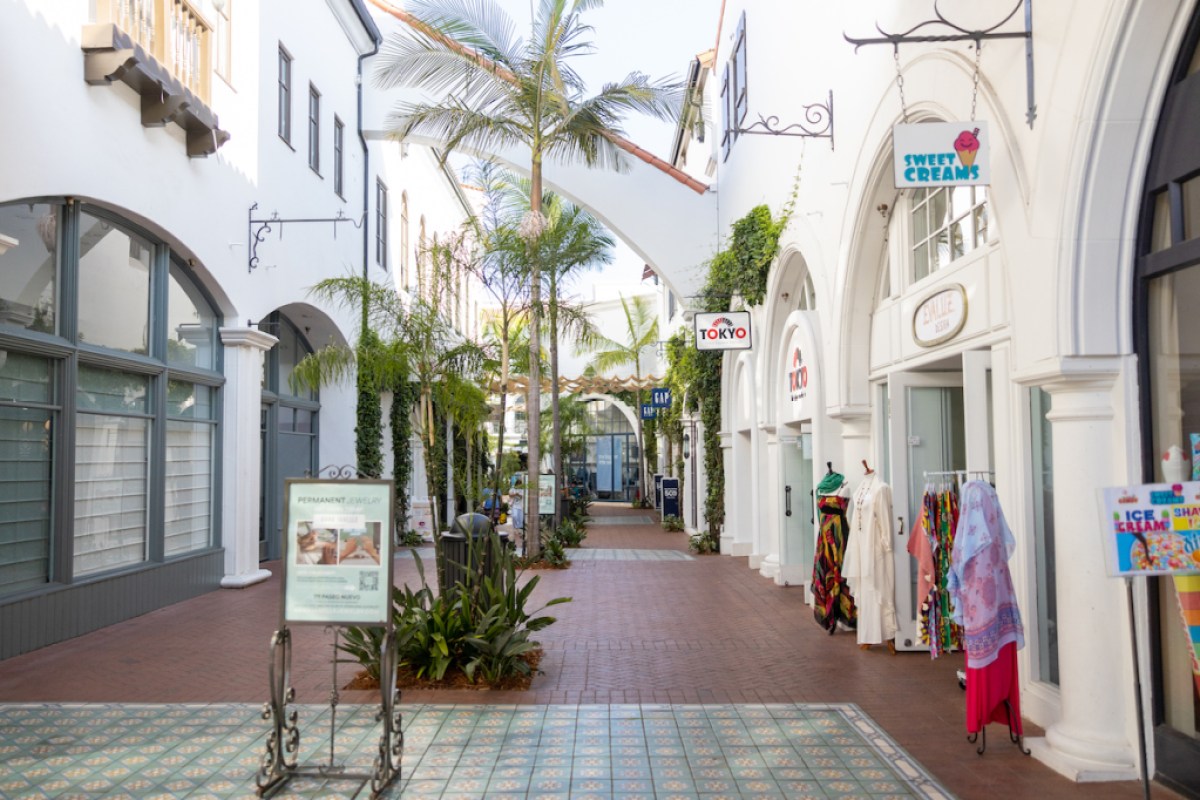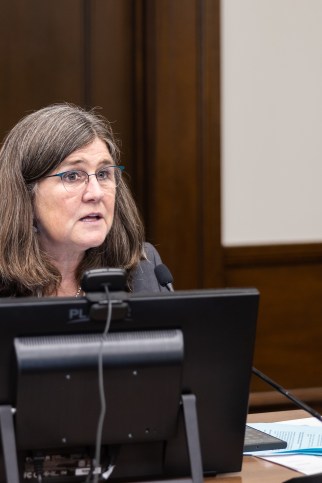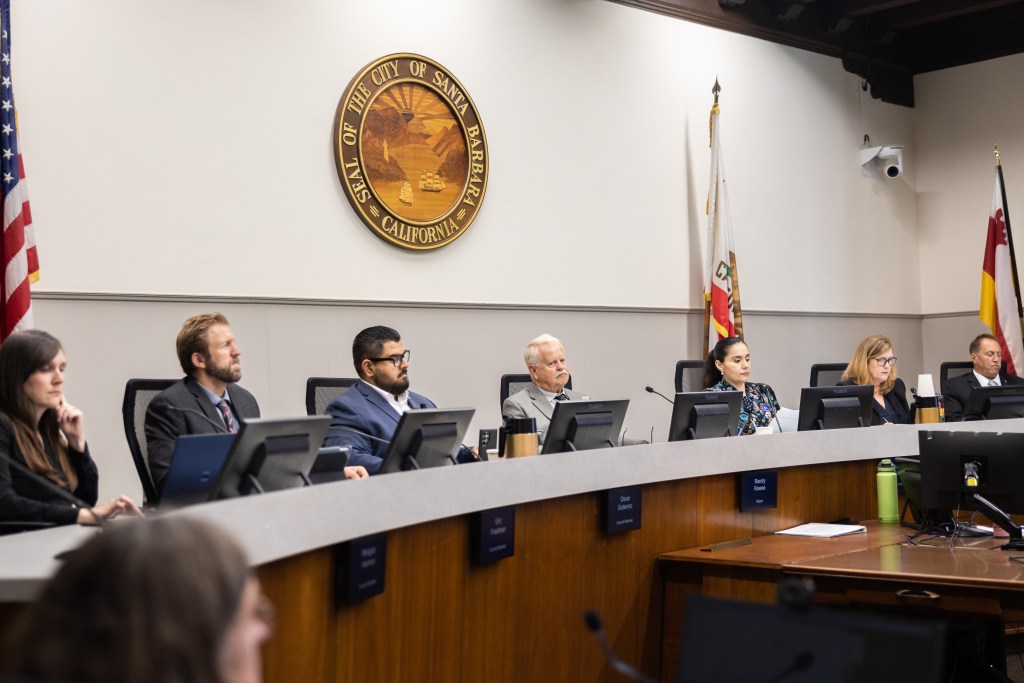Santa Barbara City Council
Excited to Rebuild
the Paseo Nuevo Mall
Five Hundred Units of Rental Housing
Proposed in the Heart of Downtown
by Nick Welsh | September 20, 2023

Members of Santa Barbara’s City Council could only find one word to describe their reaction to what might be the most singularly transformative proposal to hit downtown State Street since the 1925 earthquake, or, perhaps more obviously, the repeal of Prohibition.
That word was “exciting.”
For all six of the seven councilmembers who spoke this Tuesday, “exciting” was the first and last words out of their mouths.

That is exactly what City Administrator Rebecca Bjork most urgently wanted to hear at the meeting when she publicly unveiled plans to revitalize downtown that she has been hatching under the radar for the better part of a year. With only three months left before she retires after an impressive 35-year career at City Hall, Bjork looks to be going out with a colossal bang.
If all goes according to Bjork’s blueprint, downtown’s economically festering Paseo Nuevo shopping mall — all 240,000 square feet of it — will be demolished. In its place will spout up 500 units of rental housing. In addition, Bjork said, there will be 60,000 square feet of new retail, commercial, or office space built. It remains to be determined just how many of the rental units will go for below-market rates.
Many key details have yet to be worked out. In fact, no formal negotiations have yet to take place. But this Tuesday, a very excited City Council voted unanimously to begin the process of moving — swiftly and aggressively — toward making all this happen. In fact, two councilmembers — Eric Friedman and Michael Jordan — were so excited they vowed to lead the charge to push the city’s sacrosanct height limit to 60 feet, up from the current 48 feet, if it will help make this dream come true.
To be clear, the proposed development as currently envisioned includes the vacant Macy’s building, located at State and Ortega streets — and everything else that’s popularly regarded as part of Paseo Nuevo, except for the vacant Nordstrom building at Chapala and Canon Perdido, which has different owners.
The deal initiated by Bjork is complicated with no shortage of movable parts. Anything can go wrong. The city’s development partners are wary, worried about sudden shifts of political wind and lack of political will. Bjork is most anxious to get a “project agreement” hammered out by the time she retires this December. Delays can kill it, she worries. So too can unrealistic expectations.
A project agreement is an administrative planning tool agreed upon by the City Council after being arrived at through negotiations with the mall’s newest owner — a multibillion-dollar investment firm headquartered in New York City named AllianceBernstein.
These negotiations will determine how many rental units get built, how many are priced for high-income occupants, and how many will be at below-market rents. These negotiations will determine — in a general way — what the place will look and feel like, how open it will be to the general public, and with what mix of incomes. They will set the parameters for how much the project is expected to cost to build, how much profit the investors and developers will make, how much income it can bring in, and how much will be left over to satisfy the community benefits as envisioned by members of City Council.
Many councilmembers were quick to note that the role they play in making this project happen will define their political legacy.
For the record, the “project agreement” is just a starting point. From there, the project has to undergo the rigors of development and design review — and the public process that entails — though it’s all but certain the developers will demand and the city will grant a limit to the number of mandatory visits the developers will be required to make to review boards and commissions. Whether an environmental impact is required or not has yet to be determined. But some form of environmental review will be.
For Rebecca Bjork, the deal now before the council is the city’s first, last, best, and only hope to save downtown from the gloomy economic shadows cast by Paseo Nuevo. The “do nothing” alternative, she said, would result in “deactivated space, blight, and decline.” But the deal she envisions will put an estimated 750 people in homes on State Street. This will provide much-needed housing at a time when the State of California is cracking the whip on local communities to provide additional housing stock.


Paseo Nuevo | Credit: Ingrid Bostrom
For those tuning in late, Paseo Nuevo was originally conceived as a scheme to save downtown’s economic and cultural vitality from the long-anticipated peril posed by the big-box malls that in the Santa Barbara of the 1980s was known ominously as the “Goleta Threat.” With false starts and missteps, it took about 15 years to get Paseo Nuevo built. Community debate during its inception was intense.
City Hall signed on the dotted line for what would become Paseo Nuevo in 1985. City Hall had to relocate businesses that did not want to be relocated. City Hall had to sell millions of dollars’ worth of municipal bonds to finance the construction of the three massive municipal parking lots that provided the 1,100 parking spaces experts said were needed to accommodate the crowds who would throng downtown for Christmas shopping. The public process was both exhaustive and exhausting.
An earlier proposal for retail salvation wound up going before a vote of the people where it lost narrowly. Paseo Nuevo would emerge out of the ashes as Plan B. Santa Barbara was a different town then. It was a different City Hall, too. Back then, the City Council insisted on — and got — space in the mall for an art gallery and a performing arts stage.
Ask yourselves, how many malls have such amenities?
By contrast, the deal Bjork took to the council was put together in less than a year and behind closed doors, the stepchild of the economic decline that afflicted retail operators everywhere coupled with the historic wreckage inflicted by COVID. Bjork not only gave the councilmembers the outline of a credible plan, but she also delivered unto them a whole development team of owners, developers, architects, experts, and attorneys. The only thing missing was the silver platter.
The principals are all high-end, sophisticated, big-shot, deep-pocketed, out-of-town-operators; a few locals — architects and attorneys — however, were added to the equation to explain the local political and aesthetic customs that would otherwise take newcomers too long to learn.


Paseo Nuevo | Credit: Ingrid Bostrom
Since its inception, Paseo Nuevo has gone through a litany of new owners, all professing to have their own secret sauce to revitalize the mall and surrounding environs. The last ones were desperately seeking an extension of their land lease with City Hall just as the retail crash hit critical mass. Their public presentations were astonishingly unimpressive, and their negotiation skills were apparently just as bad.
The Planning Commission told the owners to pound sand and rejected the lease extension the owners correctly argued was essential to amortize the improvements the commissioners said they wanted. The mall owners then defaulted on a $121 million loan from a major investment operation: AllianceBernstein. Or AB Commercial for short.
That was in 2022.
Bjork, along with City Attorney Sarah Knecht — who has worked on all matters pertaining to Paseo Nuevo since 2004 — wasted little time knocking on the doors of AB Commercial. Both City Hall and AB were stuck, she pointed out. Both had a lot to lose. Paseo Nuevo had morphed into a white elephant and black hole. No rational operator was likely to show up and save the day for either one of them. AB was not in the business of running shopping malls, and now it was out $121 million. If it sold out, it would take a sizable loss.
Bjork suggested a partnership instead: to build housing in place of the mall. Although City Hall owns most of the land underneath the mall, AB Commercial, as owner of the mall itself, still has a few decades left on its lease. Even if City Hall had the money to buy out that lease — which it doesn’t — it couldn’t afford to sell or lease the land to anyone else. Under new state laws, any such transfer would be regulated under the state’s surplus land rules that prohibit City Hall from pocketing no more than 11 percent of all sales proceeds. The rest would have to go to the neighboring school districts and local government agencies. That’s not remotely enough to solve the problem posed by an economically moribund shopping mall.
Given this constricted math, Bjork reckoned, the only deal that could work would be for City Hall to transfer ownership of its land to a partnership with AB Commercial. In the legal language of real estate, it would be what’s known as a “fee-simple” transaction. Public property painstakingly amassed and paid for would be “given” to a private developer. In exchange, Santa Barbara would get rid of a blighted mall, however pleasant-looking and well-maintained by AB Commercial. And assuming there aren’t too many devils in the details — and there are bound to be some — downtown gets a major shot in the arm from 750 new residents, and city tenants get much-needed rental housing.
Little wonder councilmembers said they were excited. And it’s not like there are that many — or even any — competing options on the horizon.
What Bjork wanted from the council Tuesday was simple. “Your priorities,” she stated.

Councilmember Kristen Sneddon quipped in all seriousness, “I think I’m going to want it all.” First and foremost, she said, was housing. Specifically, as much workforce housing as can possibly be extracted. She wanted to preserve the existing walkways and paseos that make the mall accessible. She didn’t want snow-tinted windows on stay-away office spaces; she wanted it accessible to the entire community. Lastly, she said, “It needs to look and feel like Santa Barbara.”
Councilmember Friedman suggested the retail spaces be carved up into smaller spaces so that businesses don’t find themselves forced to rent more space than they can afford to pay, as is the case now.
Councilmember Jordan wanted the State Street entrance to sit lower on the ground with the taller higher elements congregated toward the Chapala-facing side. He too wanted the maximum number of below-market-rate rehousing units, acknowledging, “That will be a tough come-to-Jesus conversation.” He wanted housing restrictions: no vacation rentals, no second homes, no boutique hotels. If possible, he wanted tenancy restricted to people who worked in Santa Barbara.
Councilmember Alejandra Gutierrez said she wanted special care taken for existing mall tenants. Councilmember Meagan Harmon stressed the need to have tenants of all economic persuasions living together. By together, she meant people of all income levels needed to be spread throughout the entire complex, not in segregated silos. And it absolutely has to be integrated into the warp and weave of downtown.
Mayor Randy Rowse praised the proposal, saying it was going to be “a really nice project.” Like Bjork, he stressed the need for dispatch. “We don’t need to spend a lot of time picking out the curtains,” he stated.
Councilmember Oscar Gutierrez said nothing. To the extent he was excited, he kept such thoughts to himself.
Four members of the public testified. One represented the group that owns the Nordstrom building. One represented the Downtown Organization. Frederick Janka, President of the Board of the Museum of Contemporary Art Santa Barbara, represented the mall’s art museum that just reopened. Citizen activist Anna Marie Gott noted that had the agenda been more descriptive as to what was to be discussed a lot more than four members of the public would have showed up. She stressed the need for broader public outreach.




You must be logged in to post a comment.